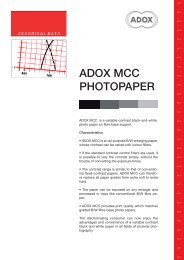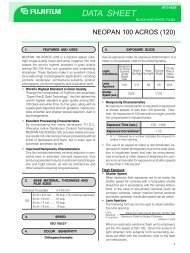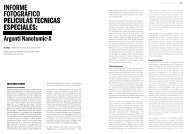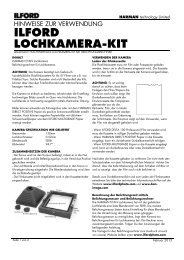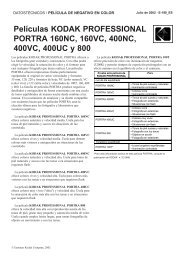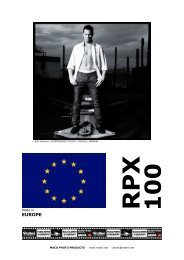Technical Data Agfa Professional Films - AgfaPhoto
Technical Data Agfa Professional Films - AgfaPhoto
Technical Data Agfa Professional Films - AgfaPhoto
Create successful ePaper yourself
Turn your PDF publications into a flip-book with our unique Google optimized e-Paper software.
<strong>Agfa</strong>color Optima withEYE VISION technologyA film's colour rendition is governed by a number of factors. Theemulsions' spectral sensitivity or sensitisation is particularlyimportant, when it comes to reproducing true-to-nature colourswith the maximum accuracy. By means of the EYE VISIONtechnology incorporated in all the <strong>Agfa</strong>color Optima films, it isnow possible to match, to a large extent, the films' sensitisationto the colour perception of the human eye. The effect is shownschematically in the following diagrams. The EYE VISIONtechnology achieves more accurate colour fidelity, and largelyeliminates the colour falsifications present in films withconventional sensitisation such as:• an unpleasant green cast with fluorescent light (e.g. neon tubes),• a shift towards red in certain blue-coloured flowers (hortensia,clematis, delphinium etc.),• the brown rendition of particular green fabric colours,• the absence of texture in certain red colours (e.g. roses).Spectral sensitivity of the eyeblue green red400 450 500 550 600 650 nmSpectral sensitivity of the film emulsions400 450 500 550 600 650 nm<strong>Agfa</strong> <strong>Professional</strong> film range<strong>Agfa</strong>color negative films:• Optima 100• Optima 200• Optima 400• Portrait 160<strong>Agfa</strong>chrome reversal films:• RSX II 50• RSX II 100• RSX II 200<strong>Agfa</strong>pan black and white negative films:• APX 100• APX 400<strong>Agfa</strong> black and white reversal films:• Scala 200xOPTIMAblue green redpreviouslyInformation on the performance characteristics of<strong>Agfa</strong> <strong>Professional</strong> filmsSensitivity (speed)Sensitivity is a measure of the response of a film to light exposure.The speed of films is based on the minimum exposure required forproducing optimum tone reproduction. It is determined accordingto international standards for b&w, colour negative, and colourreversal films that specify the exposure, chemical processing anddensitometer.The figure given on the pack applies however to the exposuretime range of 1 s to 1/10 000 s. Absolutely no sensitivity deviationsoccur with any <strong>Agfa</strong> films within this range.Reciprocity effectThe effect of an exposure of silver halide based films to light isthe product of light intensity × time of exposure, i.e. E = l × T.This reciprocity law (first defined by Bunsen and Roscoe and alsoknown as the Schwarzschild effect) holds that a 1/100 secondexposure time at a light intensity of 1 lux will yield the sameresults as an exposure time of 1 second at 100 lux. However, atintensities significantly below or above the range in which reciprocityis maintained with a given film, more exposure will berequired to achieve the same result. This is known as reciprocityfailure. With colour films the failure of reciprocity tends to bedifferent for the blue, green and/or red recording layers resultingin a shift in colour and colour contrast balance.Appropriate information about reciprocity failure and the meansfor compensation through exposure adjustments and/or use ofcolour filters is given in the technical data section.Colour sensitivityThe spectral sensitivity of <strong>Agfa</strong> colour negative, colour reversaland black and white <strong>Professional</strong> films covers the entire rangeof visible radiation.Colour balanceDaylight has a completely different colour temperature to theartificial light produced by the halogen and incandescent lampscommon in practice. (An exception is formed by the halogenmetal vapour lamps with daylight characteristics, e.g. OsramHMI and Philips MSR lights for professional use.)Colour films detect variations in the colour temperature muchmore accurately than the human eye, which receives an overallcolour impression and largely balances the differences. For thisreason colour films have to be sensitised to a certain kind ofsubject light, i.e. depending on the film type a particular colourtemperature is fixed as reference white-point during manufacture.All the <strong>Agfa</strong>color and <strong>Agfa</strong>chrome <strong>Professional</strong> films are matchedto daylight , and are designed for the spectral radiation of mixedsunlight (colour temperature approx. 5500 Kelvin). Photographyin this type of light does not require filtration, i.e. the resultswith all the films have an even, neutral colour balance.If however the colour temperature of the subject light variesdistinctly, this has to be counteracted for colour reversal filmsby camera correction filters, which prevent colour casts.2 F-PF-E3



